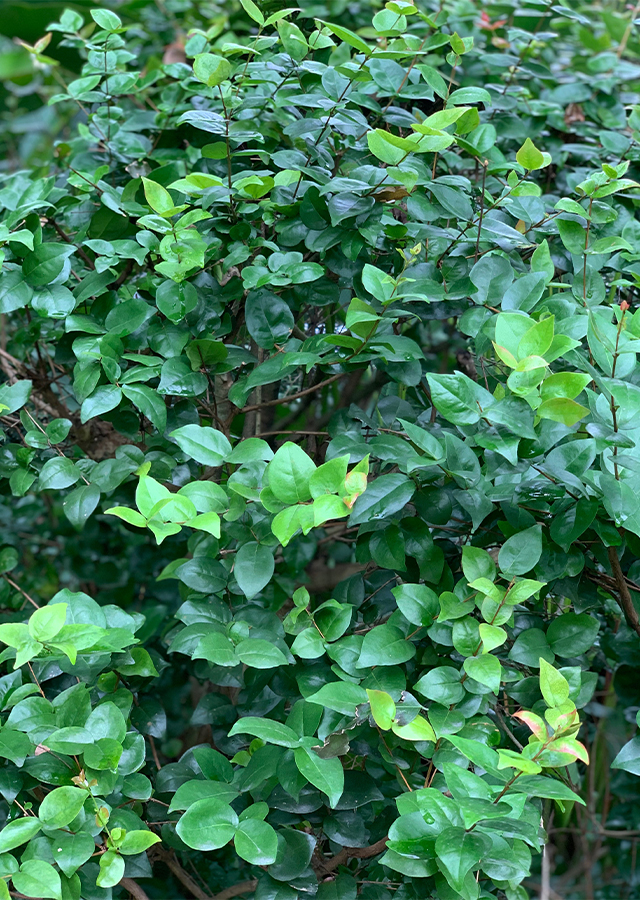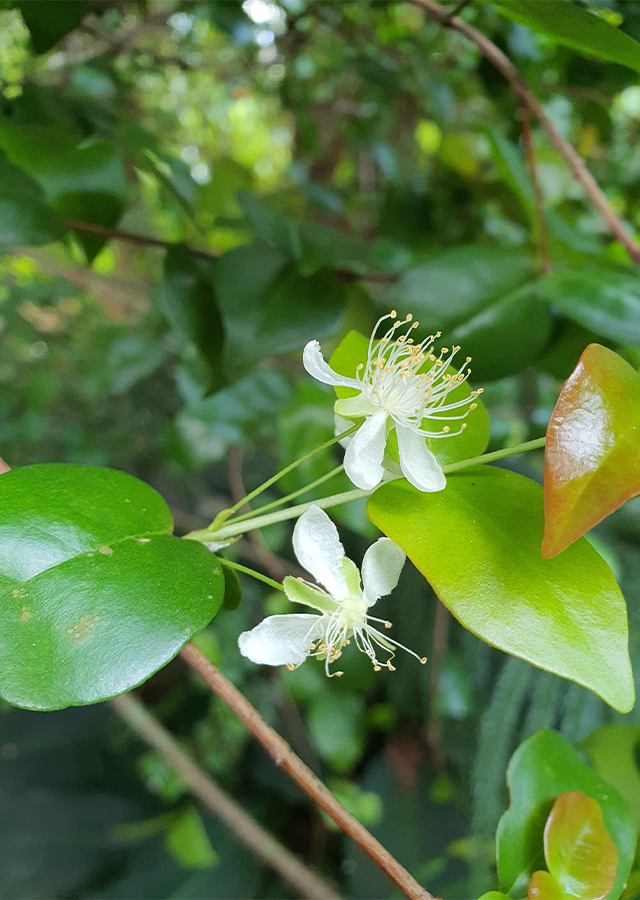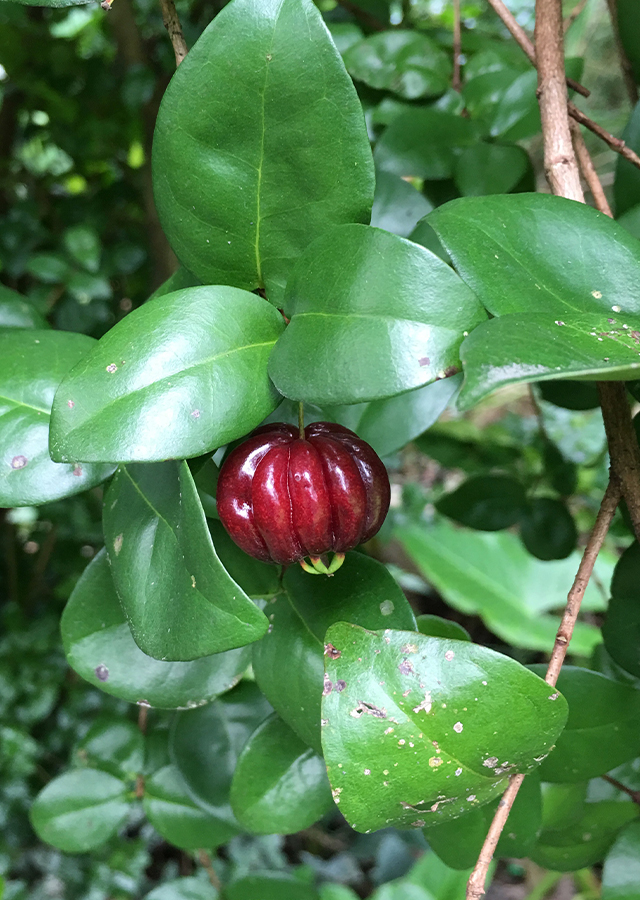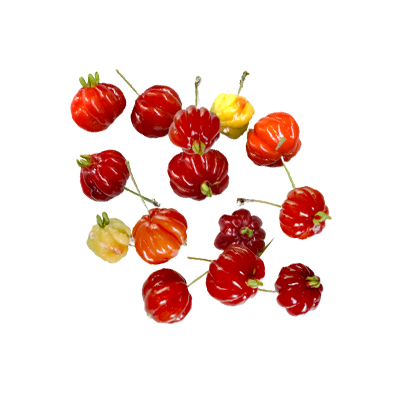Brazilian Cherry
Eugenia uniflora L.
Myrtaceae
Location in our garden
Principal



Synonym
Eugenia arechavaletae Herter
Eugenia costata Cambess.
Eugenia dasyblasta (O. Berg) Nied.
Habitus
Shrubs. Evergreen shrub or small tree with a dense canopy, that grows 6-12 m tall
Part Used
Leaves
Bark
Fruit
Roots
Growing Requirements
Full Sunshine
Drought Resistant
Habitat
Riverbanks
Forest
Coastal
Shrublands
Overview
Brazilian cherry is indigenous to the Amazon rainforest in South America. The plant is native from Surinam, Guyana and French Guiana to Eastern and Southern Brazil and to Northern, Eastern and Central Uruguay. It is cultivated in all tropical and subtropical regions as fruit and ornamental tree. It has become invasive in Bermuda and some parts of Australia.
Vernacular Names
Hong Guo Zi (Chinese), Cerisier Carré (French), Cayennekirsche (German), Goraka jambu (Sri Lanka), Pitanga (Portuguese), Pitanga (Danish).
Agroecology
Brazil cherry succeeds in warm temperate to tropical areas, up to an elevation of 1,800 m in the tropics. The ideal temperature range for growth is 12-32 °C and the annual rainfall range is 700-2,700 mm. Adaptable to a range of soil types, but intolerant of alkaline soils.
Morphology
- Roots - taproots.
- Trunk - multi-trunked tree with spreading, slender, sometimes crooked branches.
- Leaves - opposite, bronze in color when young, glossy deep green when mature, simple, entire, ovate or elliptic ovate, 3.2–4.2 by 2.3–3 cm, shortly petiolate to 1.5–3 mm long, papery, glabrous.
- Flowers - usually axillary, white, slightly fragrant. Calyx has 4 long elliptic and reflexed lobes. Petals 4 white and obovate.
- Fruits - succulent , juicy, acid sweet berries, red to very dark red when ripe, depressed globose, 1.5 cm long, 2 cm wide , 8 ridged.
- Seeds - commonly containing 1-3 seeds, though it can have a single large seed or up to 7 small seeds.
Cultivation
- Propagated by seed. It is best sown as soon as it is ripe in a partially shaded position in individual containers. A germination rate of around 80% can be expected, with the seed sprouting within 20-50 days.
- Layering and grafting
Chemical Constituents
Carotenoids, flavonoids, phenolic, tannin, citronellal, geranyl acetate, geraniol, cineole, terpinene, sesquiterpenes and polytenes.
Traditional Medicinal Uses
- The fruits exhibited high antioxidant capacity.
- The leaves were found to inhibit Staphylococcus aureus, Bacillus subtilis, Escherichia coli and Shigella dysenteriae.
- Four tannins were found to have inhibitory effect on population malignant tumours among Chinese in Southern China and South-East Asia.
- Studies have suggested anti-inflammatory, antibacterial, antinociceptive, antiproliferative, antimutagenic, mutagenic, hypotensive, hepatoprotective, anti-trypanosomal, anti-leishmanial, diuretic, neuroprotective properties.
- In Paraguay, decoction or infusion of the leaves was recommended for treating gout
- In Madeira, fruits of E. uniflora are eaten for intestinal troubles;
- In Brazil, the leaf infusion is taken as a febrifuge and astringent and for stomach problems.
- In South American, it is used to treat high blood pressure, heartburn, bronchitis, colic, and stomach aches.
- Decoction of leaves used for fever, rheumatism, dysentery, and diabetes.
- The infusion of fresh leaves had a highly significant antiinflammatory effect when administered.
Part Used
Reference Sources
- CABI. (2014). Invasive Species Compendium. Eugenia uniflora (Surinam cherry). https://www.cabi.org/isc/datasheet/23099#tosummaryOfInvasiveness. 02-02-2021
- Fern, Ken. (2014). Useful Tropical Plants. Eugenia uniflora. http://tropical.theferns.info/viewtropical.php?id=Eugenia+uniflora. 02-02-2021
- Lim, T.K. (2012). Edible Medicinal and Non-Medicinal Plants Vol. 3. 620-630. Springer Dordrecht Heidelberg London, New York.
- StuartXchange. (2016). Philippine Medicinal Plants. Pitanga. http://www.stuartxchange.org/Pitanga 02-02-2021



